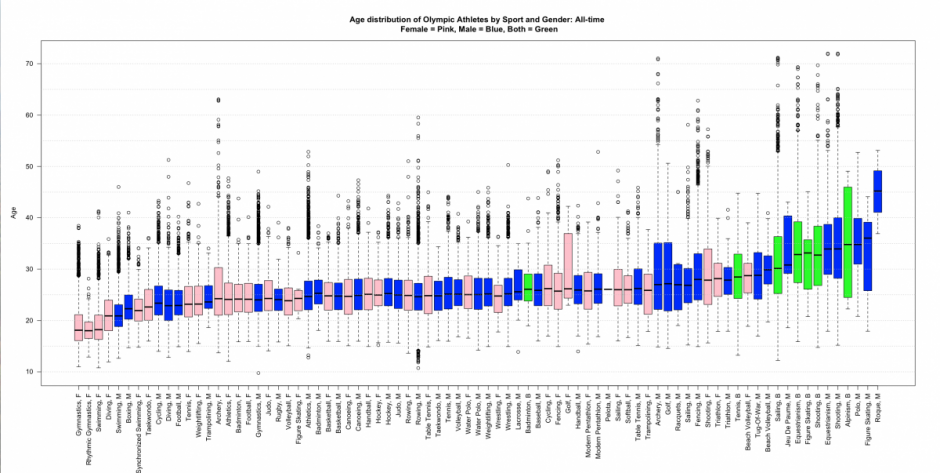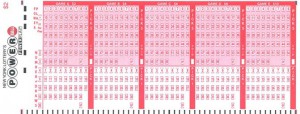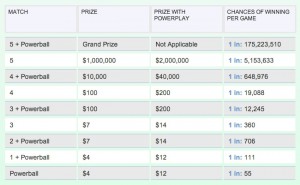On the exam last week I asked you to calculate how many different entries there are for the New York Lottery’s Powerball game, given the following instructions from on “How to Play“:
Fill in your choice of five numbers from 1 to 59 in the upper section of a game panel and select one Powerball number from 1 to 35 in the lower section of the same game panel.
Assuming that the the five numbers from 1 to 59 must be chosen “without replacement,” i.e., the same number cannot be chosen more than once, and that the order of the five numbers matters, we arrived at the following answer:
(59*58*57*56*55)*35 = 21,026,821,200
Just to review: the first part, in parentheses, is the number of permutations of length 5 taken from 1-59; in the notation of the book, 59P5, or often written as P(59, 5)–think 59 choices for the 1st number, times 58 choices for the 2nd number, and so on. Then P(59, 5) is multiplied by 35, for the 35 different choices for the Powerball number.
But as we subsequently discussed in class, it turns out that the order of the five numbers does not matter, i.e., we want the number of combinations of size 5 taken from 1-59: 59C5, or C(59, 5).
(That the five numbers 1-59 are chosen without replacement, and that they are chosen without regard to order, is clear from the format of the Powerball playcard. You fill in your 5 choices in the red-shaded part–so you can’t pick any number more than once, and you don’t specify any order:
So how do we compute C(59, 5)? As I explained, it helps to think of the number of combinations C(n, r) (of r objects selected from a group of n objects) as the number of permutations P(n, r) divided by how many of those permutations are just rearrangements of each other, i.e., that correspond to the same combination. The latter number is just how many different ways there are to list r objects, i.e., P(r, r) = r!
In terms of the Powerball entries, consider one of the P(59, 5) = (59*58*57*56*55) different permutations of length 5, for example 5-16-27-38-49. But there are many permutations that are equivalent to this if we’re thinking about combinations, i.e., if the order doesn’t matter: 5-16-27-38-49, 5-16-38-27-49, 5-16-38-49-27, and so on. If you think about it, it should be clear there are 5! = 5*4*3*2*1 such different permutations of any given 5 numbers (5 choices for the 1st place, 4 choices for the 2nd choice, etc.)
Thus,
C(n,r) = P(n,r) / r!
or, in the case of the five numbers in a Powerball entry,
C(59,5) = (59*58*57*56*55) / 5!
So the number of distinct Powerball entries is C(59,5) times 35:
35*(59*58*57*56*55) / 5! = 175,223,510
and indeed, on the “Chances of Winning” webpage the given odds of matching “5 + Powerball” is “1 in: 175,223,510”:
But that table shows that you also win something if you match some of the numbers drawn, and gives the prizes and chances of winning for matching the 5 numbers 1 to 59 (but not the Powerball), matching 4 of those numbers + the Powerball, matching 4, and so on, down to matching just the Powerball.
Where do the chances for those lesser matches come from? That gets slighty more complicated. I’ll come back and write up an explanation of those soon.





